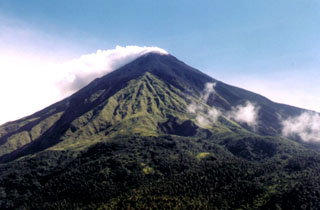Report on Karangetang (Indonesia) — 3 June-9 June 2009
Smithsonian Institution / US Geological Survey
Weekly Volcanic Activity Report, 3 June-9 June 2009
Managing Editor: Sally Sennert.
Please cite this report as:
Global Volcanism Program, 2009. Report on Karangetang (Indonesia) (Sennert, S, ed.). Weekly Volcanic Activity Report, 3 June-9 June 2009. Smithsonian Institution and US Geological Survey.
Karangetang
Indonesia
2.781°N, 125.407°E; summit elev. 1797 m
All times are local (unless otherwise noted)
CVGHM reported that during 1-6 June lava flows from Karangetang traveled 50 m E and 600 m SE. Incandescent rocks, from the main craters and ends of the lava flows, traveled as far as 2 km towards multiple river valleys, including the Keting River to the S. On 1 June, white-to-gray-to-brownish plumes rose 700 m above the main crater. Incandescent lava was ejected 500-700 m. On 4 June, tremor amplitude and the number of earthquakes decreased. During 4-6 June, white plumes rose 50-300 m from the main crater. On 7 and 8 June, fog often prevented observations and incandescent rocks were rarely seen. The Alert Level was lowered to 3 (on a scale of 1-4) on 9 June.
Geological Summary. Karangetang (Api Siau) volcano lies at the northern end of the island of Siau, about 125 km NNE of the NE-most point of Sulawesi. The stratovolcano contains five summit craters along a N-S line. It is one of Indonesia's most active volcanoes, with more than 40 eruptions recorded since 1675 and many additional small eruptions that were not documented (Neumann van Padang, 1951). Twentieth-century eruptions have included frequent explosive activity sometimes accompanied by pyroclastic flows and lahars. Lava dome growth has occurred in the summit craters; collapse of lava flow fronts have produced pyroclastic flows.
Source: Pusat Vulkanologi dan Mitigasi Bencana Geologi (PVMBG, also known as CVGHM)

